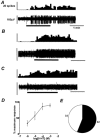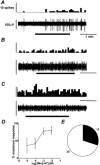Excitation of rat colonic afferent fibres by 5-HT(3) receptors
- PMID: 12411529
- PMCID: PMC2290619
- DOI: 10.1113/jphysiol.2002.025452
Excitation of rat colonic afferent fibres by 5-HT(3) receptors
Abstract
The gastrointestinal tract contains most of the body's 5-hydroxytryptamine (5-HT) and releases large amounts after meals or exposure to toxins. Increased 5-HT release occurs in patients with irritable bowel syndrome (IBS) and their peak plasma 5-HT levels correlate with pain episodes. 5-HT(3) receptor antagonists reduce symptoms of IBS clinically, but their site of action is unclear and the potential for other therapeutic targets is unexplored. Here we investigated effects of 5-HT on sensory afferents from the colon and the expression of 5-HT(3) receptors on their cell bodies in the dorsal root ganglia (DRG). Distal colon, inferior mesenteric ganglion and the lumbar splanchnic nerve bundle (LSN) were placed in a specialized organ bath. Eighty-six single fibres were recorded from the LSN. Three classes of primary afferents were found: 70 high-threshold serosal afferents, four low-threshold muscular afferents and 12 mucosal afferents. Afferent cell bodies were retrogradely labelled from the distal colon to the lumbar DRG, where they were processed for 5-HT(3) receptor-like immunoreactivity. Fifty-six percent of colonic afferents responded to 5-HT (between 10(-6) and 10(-3) M) and 30 % responded to the selective 5-HT(3) agonist, 2-methyl-5-HT (between 10(-6) and 10(-2) M). Responses to 2-methyl-5-HT were blocked by the 5-HT(3) receptor antagonist alosetron (2 x 10(-7) M), whereas responses to 5-HT were only partly inhibited. Twenty-six percent of L1 DRG cell bodies retrogradely labelled from the colon displayed 5-HT(3) receptor-like immunoreactivity. We conclude that colonic sensory neurones expressing 5-HT(3) receptors also functionally express the receptors at their peripheral endings. Our data reveal actions of 5-HT on colonic afferent endings via both 5-HT(3) and non-5-HT(3) receptors.
Figures





Similar articles
-
Deoxycholic acid activates colonic afferent nerves via 5-HT3 receptor-dependent and -independent mechanisms.Am J Physiol Gastrointest Liver Physiol. 2019 Sep 1;317(3):G275-G284. doi: 10.1152/ajpgi.00016.2019. Epub 2019 Jun 19. Am J Physiol Gastrointest Liver Physiol. 2019. PMID: 31216174
-
Differential chemosensory function and receptor expression of splanchnic and pelvic colonic afferents in mice.J Physiol. 2005 Aug 15;567(Pt 1):267-81. doi: 10.1113/jphysiol.2005.089714. Epub 2005 Jun 9. J Physiol. 2005. PMID: 15946967 Free PMC article.
-
Serotonin exerts a direct modulatory role on bladder afferent firing in mice.J Physiol. 2019 Nov;597(21):5247-5264. doi: 10.1113/JP278751. Epub 2019 Oct 13. J Physiol. 2019. PMID: 31520534
-
Irritable bowel syndrome: new agents targeting serotonin receptor subtypes.Drugs. 2001;61(3):317-32. doi: 10.2165/00003495-200161030-00001. Drugs. 2001. PMID: 11293643 Review.
-
Review article: serotonin receptors and transporters -- roles in normal and abnormal gastrointestinal motility.Aliment Pharmacol Ther. 2004 Nov;20 Suppl 7:3-14. doi: 10.1111/j.1365-2036.2004.02180.x. Aliment Pharmacol Ther. 2004. PMID: 15521849 Review.
Cited by
-
Effects of Obesity and Gastric Bypass Surgery on Nutrient Sensors, Endocrine Cells, and Mucosal Innervation of the Mouse Colon.Nutrients. 2018 Oct 17;10(10):1529. doi: 10.3390/nu10101529. Nutrients. 2018. PMID: 30336615 Free PMC article.
-
Increased responsiveness of rat colonic splanchnic afferents to 5-HT after inflammation and recovery.J Physiol. 2007 Feb 15;579(Pt 1):203-13. doi: 10.1113/jphysiol.2006.123158. Epub 2006 Nov 30. J Physiol. 2007. PMID: 17138606 Free PMC article.
-
Identification of medium/high-threshold extrinsic mechanosensitive afferent nerves to the gastrointestinal tract.Gastroenterology. 2009 Jul;137(1):274-84, 284.e1. doi: 10.1053/j.gastro.2009.02.061. Epub 2009 Mar 5. Gastroenterology. 2009. PMID: 19268671 Free PMC article.
-
The role of 5-HT3 and 5-HT4 receptors in the adaptive mechanism of colonic transit following the parasympathetic denervation in rats.J Surg Res. 2011 Dec;171(2):510-6. doi: 10.1016/j.jss.2010.05.002. Epub 2010 May 31. J Surg Res. 2011. PMID: 20691988 Free PMC article.
-
Management Options for Irritable Bowel Syndrome.Mayo Clin Proc. 2018 Dec;93(12):1858-1872. doi: 10.1016/j.mayocp.2018.04.032. Mayo Clin Proc. 2018. PMID: 30522596 Free PMC article. Review.
References
-
- Andrews PLR, Davis CJ, Bingham S, Davidson HIM, Hawthorn J, Maskell L. The abdominal visceral innervation and the emetic reflex: pathways, pharmacology, and plasticity. Canadian Journal of Physiology and Pharmacology. 1990;68:325–345. - PubMed
-
- Baron R, Janig W. Sympathetic and afferent somata projecting in hindlimb nerves and the anatomical organization of the lumbar sympathetic nervous system of the rat. Journal of Comparative Neurology. 1988;275:460–468. - PubMed
-
- Berthoud HR, Lynn PA, Blackshaw LA. Vagal and spinal mechanosensors in the rat stomach and colon have multiple receptive fields. American Journal of Physiology - Regulatory, Integrative and Comparative Physiology. 2001;280:R1371–1381. - PubMed
-
- Bertrand PP, Kunze WA, Furness JB, Bornstein JC. The terminals of myenteric intrinsic primary afferent neurons of the guinea-pig ileum are excited by 5-hydroxytryptamine acting at 5-hydroxytryptamine-3 receptors. Neuroscience. 2000;101:459–469. - PubMed
Publication types
MeSH terms
Substances
LinkOut - more resources
Full Text Sources

